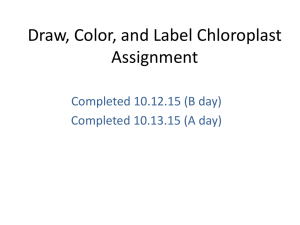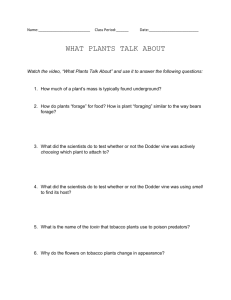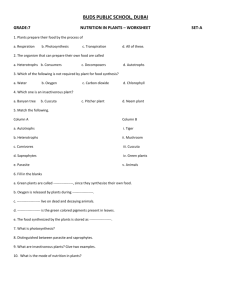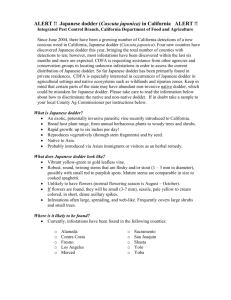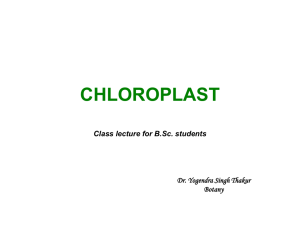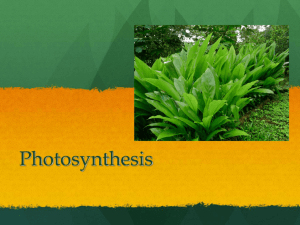Structural and Immunological Characterization of the Chloroplast Cuscuta pentagona '
advertisement
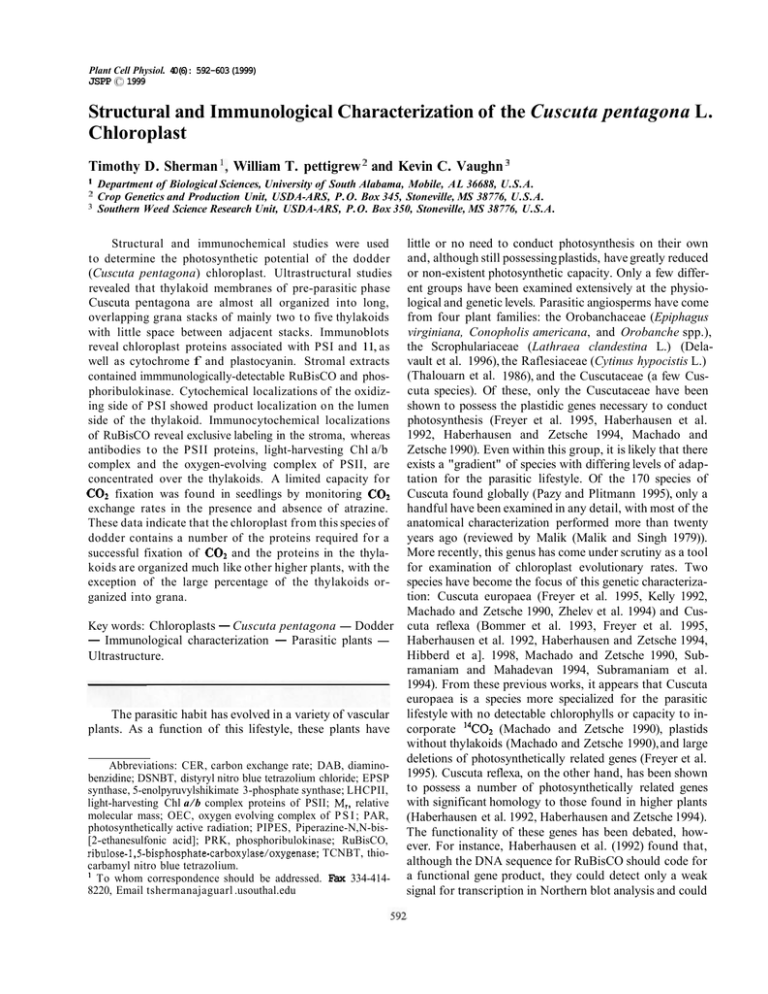
Plant Cell Physiol. 40(6): 592-603(1999) JSPP 01999 Structural and Immunological Characterization of the Cuscuta pentagona L. Chloroplast Timothy D. Sherman I , William T. pettigrew and Kevin C. Vaughn ' Department of Biological Sciences, University of South Alabama, Mobile, AL 36688, U.S.A. Crop Genetics and Production Unit, USDA-ARS, P.O. Box 345, Stoneville, MS 38776, U.S.A. ' Southern Weed Science Research Unit, USDA-ARS, P.O. Box 350, Stoneville, MS 38776, U.S.A. Structural and immunochemical studies were used to determine the photosynthetic potential of the dodder (Cuscuta pentagona) chloroplast. Ultrastructural studies revealed that thylakoid membranes of pre-parasitic phase Cuscuta pentagona are almost all organized into long, overlapping grana stacks of mainly two t o five thylakoids with little space between adjacent stacks. Immunoblots reveal chloroplast proteins associated with PSI and 11, as well as cytochrome f and plastocyanin. Stromal extracts contained immmunologically-detectable RuBisCO and phosphoribulokinase. Cytochemical localizations of the oxidizing side of PSI showed product localization on the lumen side of the thylakoid. Immunocytochemical localizations of RuBisCO reveal exclusive labeling in the stroma, whereas antibodies t o the PSII proteins, light-harvesting Chl a/b complex and the oxygen-evolving complex of PSII, are concentrated over the thylakoids. A limited capacity for C 0 2 fixation was found in seedlings by monitoring exchange rates in the presence and absence of atrazine. These data indicate that the chloroplast from this species of dodder contains a number of the proteins required for a successful fixation of C 0 2 and the proteins in the thylakoids are organized much like other higher plants, with the exception of the large percentage of the thylakoids organized into grana. Key words: Chloroplasts - Cuscuta pentagona - Dodder - Immunological characterization - Parasitic plants - Ultrastructure. The parasitic habit has evolved in a variety of vascular plants. As a function of this lifestyle, these plants have Abbreviations: CER, carbon exchange rate; DAB, diaminobenzidine; DSNBT, distyryl nitro blue tetrazolium chloride; EPSP synthase, 5-enolpyruvylshikimate 3-phosphate synthase; LHCPII, light-harvesting Chl a / b complex proteins of PSII; Mr, relative molecular mass; OEC, oxygen evolving complex of P S I ; PAR, photosynthetically active radiation; PIPES, Piperazine-N,N-bis[2-ethanesulfonic acid]; PRK, phosphoribulokinase; RuBisCO, ribulose-1,s-bisphosphate-carboxylase/oxygenase; TCNBT, thiocarbamyl nitro blue tetrazolium. To whom correspondence should be addressed. Fax 334-4148220, Email tshermanajaguarl .usouthal.edu ' little or no need to conduct photosynthesis on their own and, although still possessing plastids, have greatly reduced or non-existent photosynthetic capacity. Only a few different groups have been examined extensively at the physiological and genetic levels. Parasitic angiosperms have come from four plant families: the Orobanchaceae (Epiphagus virginiana, Conopholis americana, and Orobanche spp.), the Scrophulariaceae (Lathraea clandestina L.) (Delavault et al. 1996), the Raflesiaceae (Cytinus hypocistis L.) (Thalouarn et al. 1986), and the Cuscutaceae (a few Cuscuta species). Of these, only the Cuscutaceae have been shown to possess the plastidic genes necessary to conduct photosynthesis (Freyer et al. 1995, Haberhausen et al. 1992, Haberhausen and Zetsche 1994, Machado and Zetsche 1990). Even within this group, it is likely that there exists a "gradient" of species with differing levels of adaptation for the parasitic lifestyle. Of the 170 species of Cuscuta found globally (Pazy and Plitmann 1995), only a handful have been examined in any detail, with most of the anatomical characterization performed more than twenty years ago (reviewed by Malik (Malik and Singh 1979)). More recently, this genus has come under scrutiny as a tool for examination of chloroplast evolutionary rates. Two species have become the focus of this genetic characterization: Cuscuta europaea (Freyer et al. 1995, Kelly 1992, Machado and Zetsche 1990, Zhelev et al. 1994) and Cuscuta reflexa (Bommer et al. 1993, Freyer et al. 1995, Haberhausen et al. 1992, Haberhausen and Zetsche 1994, Hibberd et a]. 1998, Machado and Zetsche 1990, Subramaniam and Mahadevan 1994, Subramaniam et al. 1994). From these previous works, it appears that Cuscuta europaea is a species more specialized for the parasitic lifestyle with no detectable chlorophylls or capacity to incorporate 14C02 (Machado and Zetsche 1990), plastids without thylakoids (Machado and Zetsche 1990), and large deletions of photosynthetically related genes (Freyer et al. 1995). Cuscuta reflexa, on the other hand, has been shown to possess a number of photosynthetically related genes with significant homology to those found in higher plants (Haberhausen et al. 1992, Haberhausen and Zetsche 1994). The functionality of these genes has been debated, however. For instance, Haberhausen et al. (1992) found that, although the DNA sequence for RuBisCO should code for a functional gene product, they could detect only a weak signal for transcription in Northern blot analysis and could Characterization of Cuscuta pentagona Chloroplast not detect the enzyme's presence via immunoblots or by light-stimulated carbon fixation. Machado and Zetsche (1990), however, found light-stimulated carbon fixation in this same species. Recently, the inconsistent data of these groups has been resolved by discovery that Cuscuta reflexa, engaged actively in parasitism, contains photosynthetically competent cells in only a thin band of cells adjacent to the vascular tissue (Hibberd et al. 1998). In a third species, Cuscuta campestris Yuncker, photosynthetic pigments and PSII activity were examined in specimens grown under varying environmental conditions (Dinelli et al. 1993). Data from that study clearly indicates that Cuscuta campestris possesses the predominant pigments for photosynthesis (chlorophyll a and b, as well as a and β carotenes, and other accessory pigments) and low levels of PSII activity. Some previously published structural studies of Cuscuta chloroplastic structure indicate that the plastids have underdeveloped structure, consisting chiefly of lipid bodies and rudimentary thylakoids (Dodge and Lawes 1974, Laudi et al. 1974, Machado and Zetsche 1990). However, these studies were performed on plants that have parasitized a host and likely were from regions of tissue outside of the photosynthetic cells identified by Hibberd et al. (1998). Additionally, these studies were conducted at a developmental stage marked by reduced need for endogenous carbon fixation, and thus not reflective of the ultimate photosynthetic potential of the plant. In this study, we took several approaches to investigate the photosynthetic capacity of Cuscuta pentagona, a species that we have found to possess a marked green color during certain developmental stages. First, we utilized seedlings grown on a nutrient medium under defined conditions as well as field grown plants in the parasitic mode close to the time of flowering. It is at these stages that we observed maximal accumulation of chlorophyll (and presumably chloroplast development). Second, we characterized the presence of enzymes involved in photosynthesis both immunologically and cytochemically. Finally, whole seedling measurements of carbon exchange rates were conducted. This system of assays was used to examine the structural and biochemical characteristics of these plastids. Our data indicate that this species of Cuscuta has a complete assemblage of photosynthetic pigments and protein complexes for both light and dark reactions, but that preparasitic and post-parasitic tissues differ in abundance of photosynthetically-related proteins. Materials and Methods Plant material-Seeds of Cuscuta pentagona (F&J Seeds, Urbana, IL, U.S.A.) were immersed in concentrated sulfuric acid for 1 h at room temperature in a stainless steel strainer, neutralized in saturated sodium bicarbonate, and then rinsed in running 593 deionized water. The seeds were then allowed to dry briefly to improve separation of the seeds and germinated on a nutrient medium (Somerville and Ogren 1982) supplemented with 25 pg m l l ampicillin (to suppress bacterial growth) in glass culture dishes. Growth characteristics and protein profiles are unaffected by this antibiotic treatment. Seedlings of dodder were grown for up to 10 d in a non-parasitic mode on this medium under continuous light of lOOpmol m 2 s ' PAR at room temperature (2123°C) Samples of wild dodder were collected from a local population in Stoneville, MS, U.S.A. as green or orange colored stem segments. These segments were either fixed directly in the field or brought back to the laboratory where they were processed immediately for either biochemical or structural analysis. P S I and PSII cytochemistry-Partial reactions of photosynthetic electron transport were visualized cytochemically as previously described (Vaughn and Outlaw 1983, Vaughn et al. 1983). The oxidizing side of PSI was localized using diaminobenzidine (DAB) at 1 mg m l l . Reaction at this concentration is specific for PSI activity, preferentially staining the stroma lamellae and ends of grana stacks. PSII was localized using the tetrazoliums: distyryl nitro blue tetrazolium chloride (DSNBT) or thiocarbamyl nitro blue tetrazolium (TCNBT) at 1 mg m l l . These compounds receive electrons from PSII. Immunocytochemistry-Small (-1 mm) stem pieces were fixed in 3% glutaraldehyde in 0.05 M Piperazine-N,N-bis[2ethanesulfonic acid] (PIPES) buffer (pH 7.4) for 2 h at 4OC. The specimens were then washed in 0.05 M PIPES buffer (pH 7.4) and dehydrated in ethanol to 70% at 4OC. Subsequent dehydration to 100% ethanol was carried out after transferring the specimens to a freezer (-20°C) The samples were infiltrated with L.R. White resin (Polysciences, Warrington, PA, U.S.A., [soft formulation]) in 25% steps, for 2-4 h at each step and two overnight changes of 100% resin. Polymerization was carried out in BEEM@capsules (Polysciences, Warrington, PA, U.S.A.) using resin to which 100 u\ of L.R. White catalyst was added. The specimens remained at -20° for 8-10 h to ensure complete polymerization. Sections were cut with a Reichert Ultracut E ultramicrotome to a thickness corresponding to a pale gold reflectance color and mounted on either uncoated 300 mesh gold or nickel grids. The grids were then processed in the steps described previously for un-osmicated specimens (Vaughn 1989). The primary antisera were utilized at dilutions of 1 : 40 to 1 : 160. These dilutions were determined empirically depending upon the titer of the antisera preparation, the relative ability of the antisera to recognize the polypeptides on Western blots, and the lack of background labeling over cell walls and intercellular spaces. These antisera were from rabbits immunized with light-harvesting Chl a/b complex proteins of PSII (LHCPII), the 33 kDa protein of the oxygenevolving complex (OEC) of PSII (Kawata and Cheung 1990), PsaA/PsaB complex (originally described as the P7oo Chl a-binding protein) (Vierling and Alberte 1983), plastocyanin (Hauska et al. 1983), the chloroplastic coupling factor 1 (Lax and Vaughn 1986, Radunz 1980), cytochrome f (Pettigrew and Vaughn 1998), RuBisCO (Pettigrew and Vaughn 1998). RuBisCO activase (Salvucci et al. 1985), or phosphoribulokinase (McKay and Gibbs 1991). These antisera were gifts from a variety of different sources. The immunolabeling experiments were repeated on different tissues (3 batchedembeddings) and samples (3 samples/tissue). Morphometric data were collected and analyzed as described by Lax and Vaughn (Lax and Vaughn 1991). Electrophoresis and imrnunoblotting-Fresh tissue of preparasitic and parasitic dodder were homogenized with a chilled mortar and pestle in 330 mM sorbitol, 10 mM HEPES (pH 7.7 at 594 Characterization of Cuscuta pentagona Chloroplast 2OC), 1 mM EDTA, 1 mM MgC12,and 5 mM cysteine at a ratio of 5 ml buffer per gram fresh weight. Homogenate was filtered through one layer of cheesecloth and large particles removed by centrifugation for 5 min at 500Xg and 4OC. Plastids were collected at 6,000xg for 15 min, and then were disrupted in the above buffer minus sorbitol plus proteinase inhibitors (1 mM PMSF, lOyM pepstatin, 10,uM leupeptin, and 5 mM 1,10phenanthroline). Thylakoids were pelleted at 13,000 x g for 15 min. Stromal proteins from the supernatant were precipitated with four volumes of acetone at -20°C Precipitated proteins were recovered by centrifugation at 16,000 x g for 1 min. Thylakoids and stromal proteins were solubilized in 125 mM Tris (pH 6.8 at 4OC) plus protease inhibitors with brief sonication. Protein concentration was assayed by the method of Bradford (1976) and adjusted to approximately 1 mg m l with a concentrated buffer stock to yield a final solution of 125 mM Tris (pH 6.8), 10% (v/v) glycerol, 2% (w/v) lithium dodecyl sulfate, 1% (v/v) /?-mercaptoethanol, and 0.02% (w/v) bromophenol blue. Samples were heated to 37OC for 30 min and centrifuged briefly to remove insoluble material. SDS-PAGE was performed according to the method of Laemmli (1970) in a mini-gel format. Proteins were transferred to BioTrace NT nitrocellulose (Gelman Sciences, Ann Arbor, MI, U.S.A.) in 15% ethanol, 25 mM Tris, and 192 mM glycine for 1 h at 1 mA c m 2 and 1 h at 2.5 mA c m 2 . Unsaturated sites on the membranes were blocked with 0.5% (w/v) Blocking Reagent (Boehringer-Mannheim, Indianapolis, IN, U.S.A.) in 10 mM Tris pH 7.5, 150 mM NaCI (TBS) for 1 h. Blots were then exposed to primary antibody at a dilution of 1 : 1,000 to 1 : 4,000 in this blocking solution for 2 h; washed in TBS containing 0.05% (v/v) Tween-20 for 3 times for 10 rnin each. This was followed by treatment with alkaline phosphatase-conjugated goat anti-rabbit IgG (H+L) for 1 h, washed as above, and visualized with 330yg m l ' nitroblue tetrazolium and 165 yg m l ' 5bromo-4-chloro-3-indoyl phosphate in 100 mM Tris (pH 9.5 at 24OC), 100 mM NaCI, and 5 mM MgC12. Net photosynthetic measurements-C02 exchange rates (CER) were measured using a LI-COR 6200 portable photosynthesis unit (LI-COR, Lincoln, NE, U.S.A.) with a 1.0 liter volume leaf chamber. Dodder seedlings used for these measurements came from the same culture dish. Samples of equal fresh weight (100 mg) were prepared by submerging a number of plants in either a herbicide solution containing 10yM atrazine or a 0.1% ethanol solution (control for the herbicide) for 0.5 h before the CER reading. Immediately before CER measurements, the seedlings were blotted dry. he tissue samples were complet~ly anchored in the chamber during the gas exchange measurements. The experiments were repeated on several different groups of seedlings on several different sampling dates. Spectroscopy-Shoot tips of 7-days old seedlings were immersed in 80% (v/v) acetone and placed in a sealed tube maintained in darkness at 4OC. When the shoot tissue was devoid of pigment, the solvent was used to produce visible spectra (350-700 nm) with a Gilford Response spectrophotometer (Oberlin, OH, U.S.A.). Leaves of Pelargonium hortorum were treated similarly and used as an example of a typical higher plant pigment extract. Results and Discussion Structural studies-Chloroplasts of dodder are quite unlike those of typical mature C3 dicots. First, the chloroplasts are much smaller, with lengths of about 2-3 p m and widths of -1 ,urn, compared t o the 6-8 p m long chlo- roplasts of the typical C3 dicot. Within the plastid, the arrangement of thylakoids is also unique. Towards the tip of the growing seedlings, virtually all of the chloroplasts contain thylakoid doublets in which the thylakoids are appressed along their entire length (Fig. 1). There are essentially no areas where unappressed thylakoids are noted. In the most elaborate thylakoid arrangement observed, a stack of five thylakoids was detected, but again without much in the way of unappressed lamellae. In many ways, these chloroplasts are similar to what is observed in very immature leaves of dicots (Pettigrew and Vaughn 1998) in which the thylakoids exhibit a similar complete appression. Evidence of plastid division in dodder (constriction of a relatively large plastid) is noted frequently in areas of the shoot where nuclear divisions are also noted. Besides the unique arrangement of thylakoids, the dodder chloroplasts often contain thylakoid-bound crystalline inclusions (Fig. 2). The crystal contains a regular latticework of alternating electron opaque and translucent material and is quite rectangular in outline. Favorable sections reveal that a single, distended thylakoid membrane surrounds the inclusion. Such inclusions are typical of underdeveloped plastids in the epidermis, vascular tissue, and roots but are relatively uncommon occurrences in the chloroplasts of photosynthetic tissue. A n exception is found in the chloroplasts of spinach, where a similar membrane bound inclusion is noted. However, in a plastid mutant of spinach with reduced thylakoid content, the number of these inclusions is also increased (Vaughn et al. 1981). Phytoferritin aggregations are sometimes observed in the stroma, and starch grains are observed in virtually every plastid profile. Plastoglobuli are abundant and are of varying electron opacity, even within a single chloroplast. Ribosomes are found abundantly throughout the stroma and are often associated with the tops of the small grana. Clear areas of the stroma devoid of ribosomes, containing threadlike inclusions, probably represent areas of chloroplast DNA accumulation. The chloroplast envelope is invaginated, which, in thin sections, appears as paler, inclusions in the stroma (Fig. 3). Tubular structures about the diameter of microtubules are associated with the inner envelope and extend into the stroma. Frequently, these "chloroplast microtubules" occur in clusters. Although such structures have been observed in other chloroplasts (Vaughn and Wilson 1981), their function is unknown. Chloroplasts from material collected under field situations (in which there was noticeable green t o the tissues) are structurally similar to those grown under laboratory conditions, indicating that the super-stacked thylakoid configuration is not due to growth of the plants under laboratory conditions. In this greenish tissue all chloroplasts have similar morphology. In materials collected from the field, tissues that lacked any green appearance, Characterization of Cuscuta pentagona Chloroplast 595 Fig. 1 Electron micrographs illustrating the arrangement of thylakoids in the most developed dodder chloroplasts. (A) Unlike other chloroplasts where the thylakoids are separated into regions of appressed and unappressed lamellae, the thylakoids in dodder are all present in ministacks of 2-3 thylakoids with virtually no separation between adjacent grana. S=starch. (B) Higher magnification micrograph showing the appressed nature of thylakoids in dodder chloroplasts. All of the thylakoids are arranged into small grana (g) of two to three thylakoids. The region between the thylakoids (marked with arrowheads) is more electron opaque than the thylakoids typical of the appressed regions. Bars=0.5 pm in A, 0.1 pm in B. however, have no chloroplasts that possess this superstacking of thylakoids and show no immunologically detectable RuBisCO (data not shown). Surprisingly, when dodder seedlings are germinated and grown in the dark, the structure of the thylakoids is not too different from plants grown in the light. The development of the thylakoids and the size of the plastids appear to be less than those grown under continuous light (Fig. 4). Prolamellar bodies, which are prominent structures in etioplasts, are also found, albeit in a much reduced state in the etioplasts of dodder. Because prolamellar bodies are the chloroplastic sites of accumulation of protochlorophyllide (and its conversion to 596 Characterization of Cuscuta pentagona Chloroplast Fig. 2 Types of inclusions in dodder chloroplasts. Dodder chloroplasts contain inclusions found in other plastid types (A & B) as well as those rather unique to dodder. (A) Plastoglobuli (p) are of varying electron opacity and are present throughout the chloroplast, although most often associated with the thylakoids. (B) Phytoferritin crystals, which may represent a storage form of iron in these plastids, occurs in clusters in the stroma and is not membrane bound like the other inclusion type (C & D). (C) Membrane-bound crystalline inclusions are about 0.5 pm in length and contain a regular, repeating structure of electron opaque and translucent areas. (D) Higher magnification electron micrograph of the crystalline inclusion showing that these bodies are membrane-bound (arrowheads note the distended thylakoid that surrounds the crystal). Bars=0.5pm in A-C, 0.1 pm in D. Chl in light), it would appear that dodder chloroplasts contain similar mechanisms in dealing with the etioplast/ chloroplast conversion to that found in other higher plants. Cytochemistry-Partial reactions of photosynthetic electron transport may be visualized cytochemically, which allows for determination of activity as well as presence of a particular thylakoid component (Vaughn and Outlaw 1983, Vaughn et al. 1983). PSI partial reactions involve the oxidation of DAB via donation of electrons into the electron transport system close to that of plastocyanin (Vaughn and Duke 1981, Vaughn et al. 1983). When dodder chloroplasts are exposed to DAB, a strong reaction is noted in the thylakoids with more reaction towards the edge of the thylakoid stacks than in the middle (Fig. SA, B). These are consistent with the results of previous studies that show a majority of PSI activity is present in unstacked areas of lamellae (Vaughn et al. 1983). In contrast, incubation of shoot segments in the tetrazoliums, DSNBT and TCNBT, (which receive electrons from PSII) results in a Characterization of Cuscuta pentagona Chloroplast 597 Fig. 3 Imaginations from inner envelope (e) in dodder chloroplast are not unlike microtubules both in longitudinal-section (A-arrows) and cross-section (B-asterisk). These structures may be present to position the thylakoids away from the plastid envelope. Bars= 0.1 urn. reaction that is primarily present in the stacked areas of thylakoid membranes (not shown). The latter reaction is weak relative to PSII cytochemical localizations in other higher plants (e.g., Vaughn et al. 1983), but this may be due to the poor penetration of the cytochemical reagents or the greater sensitivity of the PSII reactions to aldehyde fixation. Only cells that are cut open react with the reagent, indicating that poor penetration is the major obstacle in PSII staining in dodder. Immunocytochemistry-The light harvesting complex of PSII and RuBisCO are the major proteins of the thylakoids and stroma, respectively. Immunocytochemical localizations with antibodies to these proteins reveal specific labeling of the thylakoids and stroma. Labeling of RuBisCO is noted throughout the stroma (Fig. 6 ) . A relatively strong localization is also noted for the OEC of PSII Fig. 4 Ultrastructure of plastids from dark-grown dodder seedlings. (A) Dodder etioplasts are relatively simple organelles with the thylakoids less extensive and present more as single membranes than in the light-grown material. (B) In addition, the etioplasts contain very small prolamellar bodies, indicative of an accumulation of protochlorophyllide. Bar=0.5 pm in A, 0.1 pm in B. Characterization of Cuscuta pentagona Chloroplast Fig. 5 Cytochemical detection of PSI (DAB oxidation by PSI) partial reactions in dodder chloroplasts. (A) Strong PSI reaction fills the lumen of the thylakoids when DAB is utilized as an electron donor to PSI. (B) Higher magnification micrograph allowing comparison between the positive reaction on the thylakoids (t) and the absence of reaction on the envelope membrane. S=starch, pg=plastoglobuli; Bars=1.0 pm in A; 0.5 pm in B. (Fig. 7B) and this thylakoid distribution is identical to that obtained for the LHCPII. However, the level of the labeling with all of these sera is much less than is observed in developed chloroplasts or even rather underdeveloped ones of other higher plants (e.g., Pettigrew and Vaughn 1998). None the less, the localization of these proteins in the chloroplasts demonstrates that: (1) the uptake mechanisms for chloroplast proteins encoded by nuclear DNA is operative, (2) signaling mechanisms that send each component to the proper final site must be functioning, and (3) the chloroplast ribosomes observed are making a functional product (i.e. the large subunit of RuBisCO). Immunochemical studies-Chloroplast-enriched fractions of pre-parasitic and parasitic dodder were analyzed by a number of single and gradient gel formats with their proteins subsequently blotted to a number of membrane types. Proteins of LHCPII and enzymes of the carbon fixation pathway are present in extracts of dodder and have relative molecular masses consistent with literature values for these polypeptides [RuBisCO, 52 kDa; OEC, 16 to 32 kDa; LHCPII, 26 kDa; and cytochrome f, 32 to 34 kDa (Chia et al. 1986); glutamine synthetase, 46 to 50 kDa (Hopfner et al. 1988); EPSP synthase, 48 kDa (Kishore et al. 1988); phosphoribulokinase, 39.2 kDa (McKay and Gibbs 1991); plastocyanin, 10.4 kDa (Ramshaw et al. 1974); GroEL, 60 kDa (Vierling 1991)]. Protein extracts prepared in a like manner from spinach were electrophoresed along with those from dodder to allow for direct comparisons of chloroplast protein sizes (Fig. 8). Mass values for proteins from spinach extracts closely parallel those from the dodder extracts (Fig. 9, 10). It is not possible to make statements concerning relative abundance of these proteins based on the intensity of immunoreactions, however, because the antibodies utilized were not prepared to dodder antigens. The immunoblots are consistent with immunogold labeling experiments in revealing that photosynthetically-related proteins are present but not to the extent found in a dicot such as spinach. Although comparisons of Characterization of Cuscuta pentagona Chloroplast 599 Immunogold localization of RuBisCO in un-osmicated sections of 5-day old green stem material embedded in L.R. White resin. Gold particles are found throughout the stroma. S=starch; v=vacuole. Bar=0.5 pm. Fig. 6 protein abundance between dodder and spinach extracts may be problematic due to species differences in the antigenic similarity of the polypeptides, changes in protein abundance between pre- and post-parasitic dodder are evident from the blots that were loaded with equal amounts of total protein. There appear to be developmental changes in abundance of photosynthetically related proteins between pre- and post parasitic dodder. There is little effect of parasitism on abundance of cytochrome f, LHCPII, and OEC, but the carbon-fixing enzymes, RuBisCO and phosphoribulokinase, are greatly reduced, as is the lumenlocalized plastocyanin (Fig. 9). This differential presence extends to other chloroplast-localized, but non-photosynthetic proteins, with EPSP synthase and the chaperonin GroEL showing reduced abundance in post-parasitic tissues (Fig. 10). Strangely, glutamine synthetase seems to be present in greater abundance after parasitism and may reflect changes in nitrogen metabolism associated with the changed lifestyle. Immunostaining of the anti-PsaA/ PsaB complex is consistently weak, whereas the staining for the two PSII related proteins are quite strong. This is in contrast to the cytochemical studies that indicated little PSII activity relative to that of PSI. These results are confusing. The discrepancy may result from poor recognition of the PsaA/PsaB complex of dodder by the antiserum used in this work (which was raised to monocot PsaA/ PsaB complex) or that the antiserum had lost activity over time with storage. Alternatively, the limited number of PSI complexes found in dodder are much more active in these chloroplasts that have such small regions of unstacked lamellae (where PSI activity is normally found (Vaughn et al. 1983)). There are some notable proteins that were detected on immunoblots of spinach chloroplast membrane and soluble proteins but not on those of dodder. These include coupling factor I, RuBisCO activase, and PsaA/ PsaB complex. Antisera to these proteins produced weak signals on spinach immunoblots and so it is possible that these proteins are present in Cuscuta pentagona, but in amounts that are below the detection limit with the methodology utilized here. Spectroscopy-Acetone extracts of dodder grown under laboratory conditions produced absorption spectra qualitatively similar to those of geranium (Pelargonium hortorum). Characteristic peaks for carotenoids (400 nm470 nm) and Chls (600 nm-665 nm) are seen in both extracts, although at lower abundance in the dodder tissue. This is in agreement with a more in-depth pigment analysis of these pigments in the related species, Cuscuta campestris (Dinelli et al. 1993). Their study showed that field-grown dodder contains a full complement of photosynthetic pig- 600 Characterization of Cuscuta pentagonu Chloroplast Fig. 7 Immunogold localization of the light-harvesting Chl a / b complex of PSII (A) and the 33 kDa protein of the oxygen-evolving complex of PSII (B) in un-osmicated sections of 5-day old green stem material embedded in L.R. White resin. Unlike the stromal reaction found for RuBisCO (Fig. 6), all of the immunogold reaction is found on the thylakoids (t). Clear spaces in the stroma between the rows of thylakoid are probably areas containing plastid DNA. Bars=0.5 Dm. ments including α and carotenes, Chls a and b, luthein, antheroxanthin, and violaxanthin. Net photosynthetic measurements-Although other evidence presented here indicates that Cuscuta pentagona seedlings contain the necessary components for a functional photosynthetic system, the gas exchange of these plants is dominated by respiration. A net evolution of C 0 2 from dodder under light conditions rather than a net uptake of C 0 2 evidence this. The functionality of the Cuscutapentagona carbon-fixing system was demonstrated by comparing gas exchange measurements from atrazinetreated and untreated control dodder samples. The atrazine-treated dodder evolved C 0 2at approximately a 2-fold greater rate than the untreated control (0.017 pmol C 0 2 sK1g FWK1and 0.009,umol C 0 2 sK1g FWK1,respectively. Treatments are significantly different at the 0.01 probability level). Atrazine inhibited what little photosynthesis was occurring in the dodder and thereby resulted in a net increase in C 0 2evolution from the treated sample. This is in agreement with results found for mature tissues of Cuscuta reflexa; C 0 2 evolution decreased with increasing light intensity but never rose above the C 0 2 compensation point for any light intensity tested (Hibberd et al. 1998). The data we present here are consistent with the growth behavior of dodder seedlings, which grow vigorously for a week to ten days in the absence of a host, and then senesce quickly thereafter. It is possible that the low level of photosynthetic carbon fixation that was measured here is simply a supplement to stored reserves that increase the time in which the young seedling can locate and parasitize a suitable host. Collectively, along with other published reports, these data indicate that there is likely to be a spectrum of the chloroplast development among dodder species. Clearly, of the dodder that have been investigated, Cuscuta europaea appears to be the most adapted to a parasitic lifestyle with a number of deletions of photosyntheticallyrelated genes and essentially no development of thylakoid membranes (Freyer et al. 1995, Machado and Zetsche 1990). Developmentally, Cuscuta reflaa may be next in Characterization of Cuscuta pentagona Chloroplast A B C Std. - -.?ae . b .. EPSP .. aro EL Fig. 10 Immunoblots of various non-photosynthetic proteins Fig. 8 Representative protein profiles and a typical immunoblot of chloroplast extracts from young dodder seedlings (A), parasitic field-grown dodder (B), and spinach (C). Plastids were isolated from tissues by differential centrifugation. These were lysed and separated into thylakoid and stromal fractions by further centrifugation. Thylakoid fractions were used for these gels. Lanes were normalized for equal total protein load. Samples were subjected to SDS-PAGE (12.5% gel) and either stained for total protein with Coomassie blue R-250 (right panel) or transferred to nitrocellulose and probed with antibodies to light-harvesting Chl a / b complex of PSI1 (left panel). line. A number of photosynthetically-related genes have been identified in the genome of this species and lightstimulated carbon fixation was shown t o be present, but only weak transcription of mRNA for RuBisCO and no immunologically detectable protein for this enzyme could be demonstrated (Haberhausen et al. 1992, Machado and Zetsche 1990). Recently, however, Hibberd et al. (1998) have shown that in internodal areas of mature tissue from from chloroplast extracts from young dodder seedlings, parasitic field-grown dodder, and spinach. Extracts prepared as described in Figure 9. Stromal extracts were used for all blots. this species, photosynthesis is localized t o a ring of cells adjacent to the vascular tissue, between the pith and the cortex. No ultrastructure of this tissue was presented in that work, and so it is not possible to determine what similarities these photosynthetic cells hold t o those of Cuscutapentagona tissues that we have characterized here. We have found that material collected from the field have differing chloroplasts consistent with the tissue in which they are present. Those in greenish tissue (i.e., those associated with floral development and those near haustorial junctions) have chloroplasts with stacking of thylakoid membranes, as well as cytochemical and immunological evidence for active photosynthesis. Tissues that are orange in color have limited thylakoid stacking and n o detectable photosynthetic ability. In Cuscutapentagona, we have not identified the ring of photosynthetic cells found in by Hibberd et al. (1998) in Cuscuta reflexa. It is also of interest A B C A B C - PRK - Fig. 9 Immunoblots of various photosynthetic proteins from chloroplast extracts of young dodder seedlings, parasitic field-grown dodder, and spinach. Plastids were isolated from tissues by differential centrifugation. These were lysed and separated into thylakoid and stromal fractions by further centrifugation. Stromal extracts were used to produce blots shown in the panel on the right. Thylakoid extracts were used for blots shown in the panel on the left. Each blot contained extracts from non-parasitic dodder (A), parasitic dodder (B), and spinach (C). Lanes were normalized for equal total protein load. Samples were subjected to SDS-PAGE, transferred to nitrocellulose, and probed with antibodies to the indicated protein. Characterization of Cuscuta pentagona Chloroplast 602 that the dodder pictured in the work of Hibberd et al. (1998) is markedly greener than any of the Cuscuta pentagona tissue that we have found. It is quite likely that Cuscuta pentagona (a new world species) is physiologically distinct from Cuscuta reflexa (an old world species) and may have adapted differently to the parasitic lifestyle. Alternatively, the specialized anatomy found in Cuscuta reflexa may be indicative of a greater degree of adaptation to the parasitic habit than that of Cuscuta pentagona. It is likely that further investigation into other members of the genus Cuscuta may produce a spectrum of individuals with varying degrees of adaptation to the parasitic lifestyle that are intermediate to C. europaea and these other two species (or perhaps even more extremely or less adapted than these characterized species). As such, these intermediate species would serve as useful tools for the study of chloroplast function and chloroplast genome evolution. W e would like t o extend thanks t o L y n n Libous-Bailey f o r excellent technical assistance. Mention of a trademark, propriet a r y product, o r vendor does n o t constitute a guarantee or warranty o f t h e product by t h e United States Department of Agriculture a n d does n o t imply its approval t o t h e exclusion o f other products or vendors t h a t m a y also b e suitable. References Bommer, D., Haberhausen, G. and Zetsche, K. (1993) A large deletion in the plastid DNA of the holoparasitic flowering plant Cuscuta reflexa concerning two ribosomal proteins (rpl2, rpl23), one transfer RNA (trn1) and an ORF 2280 homologue. Curr. Genet. 24: 171-176. Bradford, M.M. (1976) A rapid and sensitive method for the quantitation of microgram quantities of protein utilizing the principle of protein-dye binding. Anal. Biochem. 72: 248-254. Chia, C.P., Duesing, J.H., Watson, J.L., Guy, R. and Arntzen, C.J. (1986) Characterization of cytoplasmic mutants of Nicotiana tabacum with altered photosynthetic function. Curr. Genet. 10: 469-479. Delavault, P.M., Russo, N.M., Lusson, N.A. and Thalouarn, P.A. (1996) Organization of the reduced plastid genome of Lathraea clandestina,an achlorophyllous parasitic plant. Physiol. Plant. 96: 674-682. Dinelli, G., Bonetti, A. and Tibiletti, E. (1993) Photosynthetic and accessory pigments in Cuscuta campestris Yuncker and some host species. Weed Res. 33: 253-260. Dodge, J.D. and Lawes, G.B. (1974) Plastid ultrastructure in some parasitic and semi-parasitic plants. Cytobiologie 9: 1-9. Freyer, R., Neckermann, K., Maier, R. and Kossel, H. (1995) Structural and functional analysis of plastid genomes from parasitic plants: loss of an intron within the genus Cuscuta. Curr. Genet. 27: 580-586. Haberhausen, G., Valentin, K. and Zetsche, K. (1992) Organization and sequence of photosynthetic genes from the plastid genome of the holoparasitic flowering plant Cuscuta reflexa. Mol. Gen. Genet. 232: 154-161. Haberhausen, G. and Zetsche, K. (1994) Functional loss of all ndh genes in an otherwise relatively unaltered plastid genome of the holoparasitic flowering plant Cuscuta reflexa. Plant Mol. Biol. 24: 217-222. Hauska, G., Hurt, E., Gabellini, N. and Lockau, W. (1983) Comparative aspects of quinol-cytochrome c/plastocyanin oxidoreductases. Biochim. Biophys. Acta 726: 97-133. Hibberd, J.M., Bungard, R.A., Press, M.C., Jeschke, W.D., Scholes, J.D. and Quick, W.P. (1998) Localization of photosynthetic metabolism in the parasitic angiosperm Cuscuta reflexa. Planta 205: 506-513. Hopfner, M., Reifferscheid, G. and Wild, A. (1988) Molecular composition of glutamine synthetase of Sinapsis alba L. Z. Naturforsch. 43c: 194-198. Kawata, E.E. and Cheung, A.Y. (1990) Molecular analysis of an aurea photosynthetic mutant (Su/Su) in tobacco: LHCP depletion leads to pleiotropic mutant phenotypes. EMBO J. 9: 4197-4203. Kelly, C.K. (1992) Resource choice in Cuscuta europaea. Proc. Natl. Acad. Sci. USA 89: 12194-12197. Kishore, G., Shah, D., Padgette, S., della-Cioppa, G., Gasser, C., Re, D., Hironaka, C., Taylor, M., Wibbenmeyer, J., Eichholtz, D., Hayford, M., Hoffman, N., Delannay, X., Horsch, R., Klee, H., et al. (1988) 5enolpyruvylshikimate 3-phosphate synthase: from biochemistry to genetic engineering of glyphosate tolerance. In Biotechnology for Crop Protection. Edited by Hedrin, P.A., Menn, J.J. and Hollingworth, R.M. Vol. 379. American Chemical Society. Laemmli, U.K. (1970) Cleavage of structural proteins during the assembly of the head of bacteriophage T4. Nature 227: 680-685. Laudi, G., Medeghini Bonatti, P. and Fricano, G. (1974) Ultrastructure of plastids of parasitic higher plants. V. Influence of light on Cuscuta plastids. Isr. J. Bot. 23: 145-150. Lax, A.R. and Vaughn, K.C. (1986) Lack of correlation between effects of tentoxin on chloroplast coupling factor and chloroplast ultrastructure. Physiol. Plant. 66: 384-391. Lax, A.R. and Vaughn, K.C. (1991) Co-localization of polyphenol oxidase and photosystem II proteins. Plant Physiol. 96: 26-31. Machado, M.A. and Zetsche, K. (1990) A structural, functional and molecular analysis of plastids of the holoparasites Cuscuta reflexa and Cuscuta europaea. Planta 181: 91-96. Malik, C.P. and Singh, M.B. (1979) Physiological and biochemical aspects of parasitism in Cuscuta-a review. In Annual Review of Plant Sciences. Edited by Malik, C.P. pp. 67-113. Vol. 1979. Kalyani Publishers, New Delhi, India. McKay, R.M.L. and Gibbs, S.P. (1991) Immunocytochemical localization of phosphoribulokinase in microalgae. Bot. Acta 104: 367-373. Pazy, B. and Plitmann, U. (1995) Chromosome divergence in the genus Cuscuta and its systematic implications. Caryologia 48: 173-180. Pettigrew, W.T. and Vaughn, K.C. (1998) Physiological, structural, and immunological characterization of leaf and chloroplast development in cotton. Protoplasma 202: 23-37. Radunz, A. (1980) Binding of antibodies onto the thylakoid membrane. VI. Asymmetric distribution of lipids and proteins in the thylakoid membrane. Z. Naturforsch. 35c: 1024-1031. Ramshaw, J.A., Scawen, M.D. and Boulter, D. (1974) The amino acid sequence of plastocyanin from Vicia faba L. (broad bean). Biochem. J. 141: 835-843. Salvucci, M.E., Portis, A.R. and Ogren, W.L. (1985) A soluble chloroplast protein catalyzes ribulose bisphosphate carboxylase/oxygenase activation in vivo. Photosynth. Res. 7: 193-201. Somemille, C.R. and Ogren, W.L. (1982) Isolation of photorespiration mutants in Arabidopsis thaliana. In Methods in Chloroplast Molecular Biology. Edited by Edelman, M., Hallick, R.B. and Chua, N.-H. pp. 129-138. Elsevier Biomedical Press. New York. Subramaniam, K. and Mahadevan, S. (1994) The cDNA sequence of cytochrome b5 associated with cytokinin-induced haustoria formation in Cuscuta reflexa. Gene 149: 375-376. Subramaniam, K., Ranie, J., Srinivasa, B., Sinha, A. and Mahadevan, S. (1994) Cloning and sequence of a cDNA encoding a novel hybrid proline-rich protein associated with cytokinin-induced haustoria formation in Cuscuta reflexa. Gene 141: 207-210. Thalouarn, P., Rey, L. and Renaudin, S. (1986) Carbon nutrition in Rafflesiaceae holoparasite Cytinus hypocistis L. fixed on, or experimentally isolated from the host Cistus monospeliensis L. J. P l a n t P h y s i o l . 123: 271-281. Vaughn, K.C. (1989) Subperoxisomal localization of glycolate oxidase. Histochemisty 91: 99-105. Vaughn, K.C., Coyle, P.C. and Wilson, K.G. (1981) Modifications of plastid ultrastructure in an efficient yellow mutant of spinach. Photosynthetic~15: 201-204. Vaughn, K.C. and Duke, S.O. (1981) Cytochemical localization of photosystem II donor sites. Histochemistry 73: 363-369. Vaughn, K.C. and Outlaw, W.H., Jr. (1983) Cytochemical and cytofluorometric evidence for guard cell photosystems. Plant Physiol. 71: 420- Characterization of Cuscuta pentagona Chloroplast 424. Vaughn, K.C., Vierling, E., Duke, S.O. and Alberte, R.S. (1983) Immunocytochemical and cytochemical localization of Photosystem I and II Plant Physiol. 73: 203-207. Vaughn, K.C. and Wilson, K.G. (1981) Improved visualization of plastid fine structure: plastid microtubules. Protoplasma 108: 21-27. Vierling, E. (1991) The roles of heat shock proteins in plants. Annu. Rev. Plant Physiol. Mol. Biol. 42: 570-620. 603 Vierling, E. and Alberte, R.S. (1983) The P700 chlorophyll a-protein: purification, characterization and antibody preparation. Plant Physiol. 72: 625-633. Zhelev, Z., Stanilova, S. and Carpenter, B. (1994) Isolation, partial characterization and complement inhibiting activity of a new glycoprotein from Cuscuta europea. Biochem. Biophys. Res. Commun. 202: 186194. (Received August 10, 1998; Accepted April 3, 1999)
